Detailed Report on Communication Barriers, Theories, & Recommendations
VerifiedAdded on 2023/06/12
|8
|1979
|138
Report
AI Summary
This report assesses the effectiveness and significance of communication, focusing on barriers and recommendations for improvement. It covers various organizational communication theories, including formal, written, directional, bureaucratic management, and scientific management. The report identifies physical, emotional, organizational structure, perceptual, and interpersonal barriers to communication. Recommendations to overcome these barriers include appropriate vocabulary, communicating one thing at a time, fostering a desire to communicate, ensuring effective understanding, and choosing distraction-free environments. The analysis concludes that effective communication is crucial for organizational function and highlights the importance of addressing barriers through strategies like motivation, effective communication channels, and training programs.
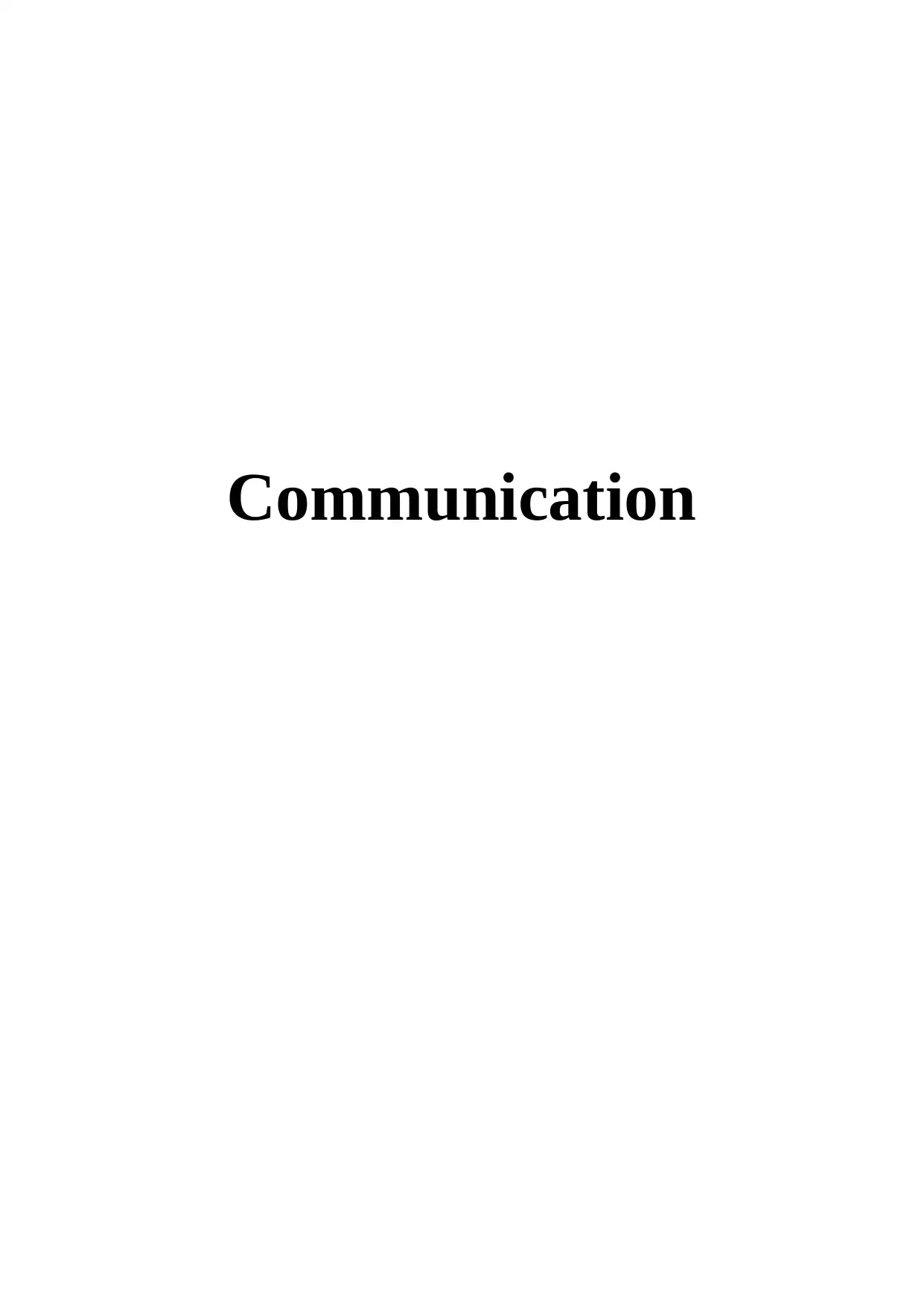
Communication
Paraphrase This Document
Need a fresh take? Get an instant paraphrase of this document with our AI Paraphraser
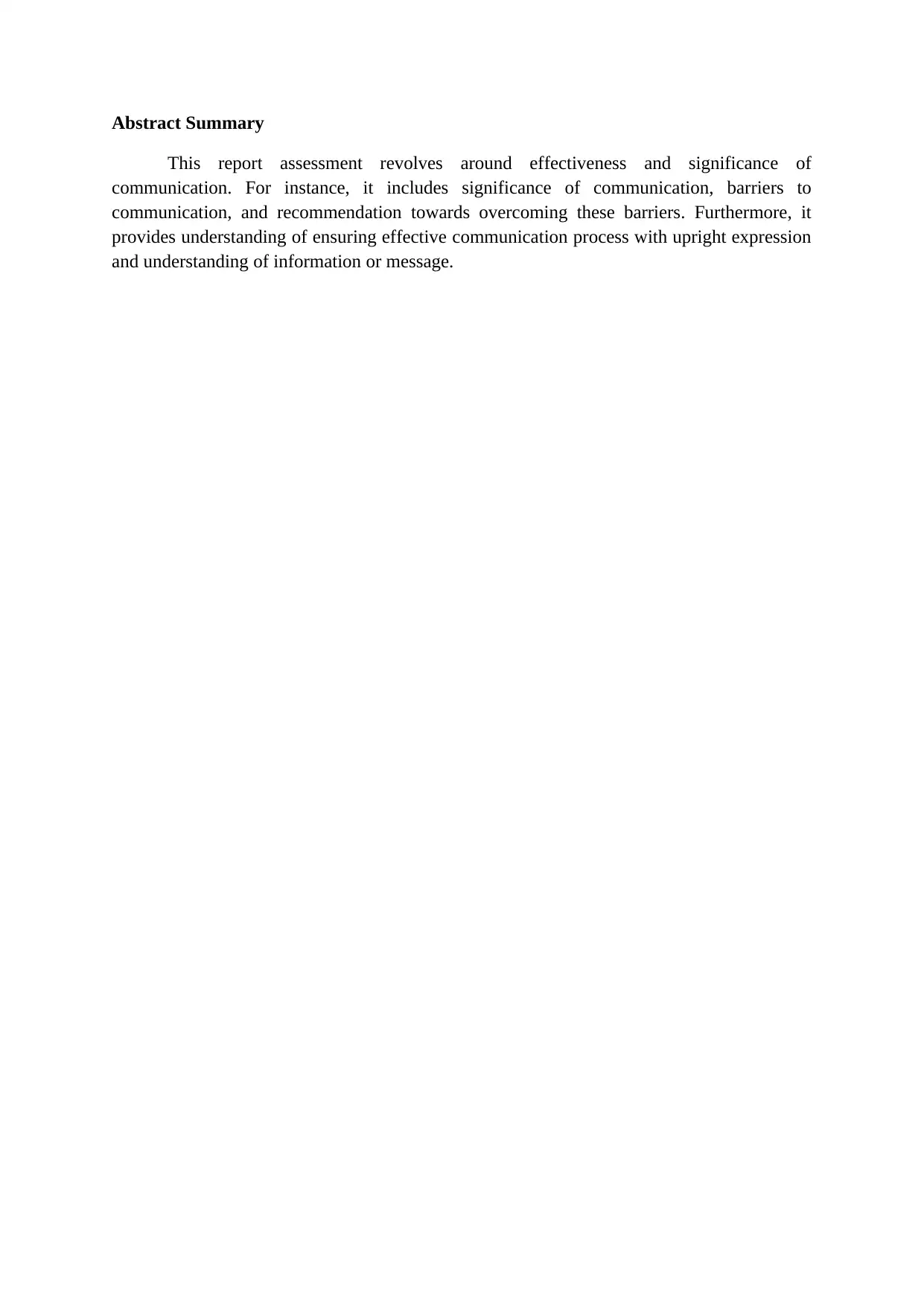
Abstract Summary
This report assessment revolves around effectiveness and significance of
communication. For instance, it includes significance of communication, barriers to
communication, and recommendation towards overcoming these barriers. Furthermore, it
provides understanding of ensuring effective communication process with upright expression
and understanding of information or message.
This report assessment revolves around effectiveness and significance of
communication. For instance, it includes significance of communication, barriers to
communication, and recommendation towards overcoming these barriers. Furthermore, it
provides understanding of ensuring effective communication process with upright expression
and understanding of information or message.
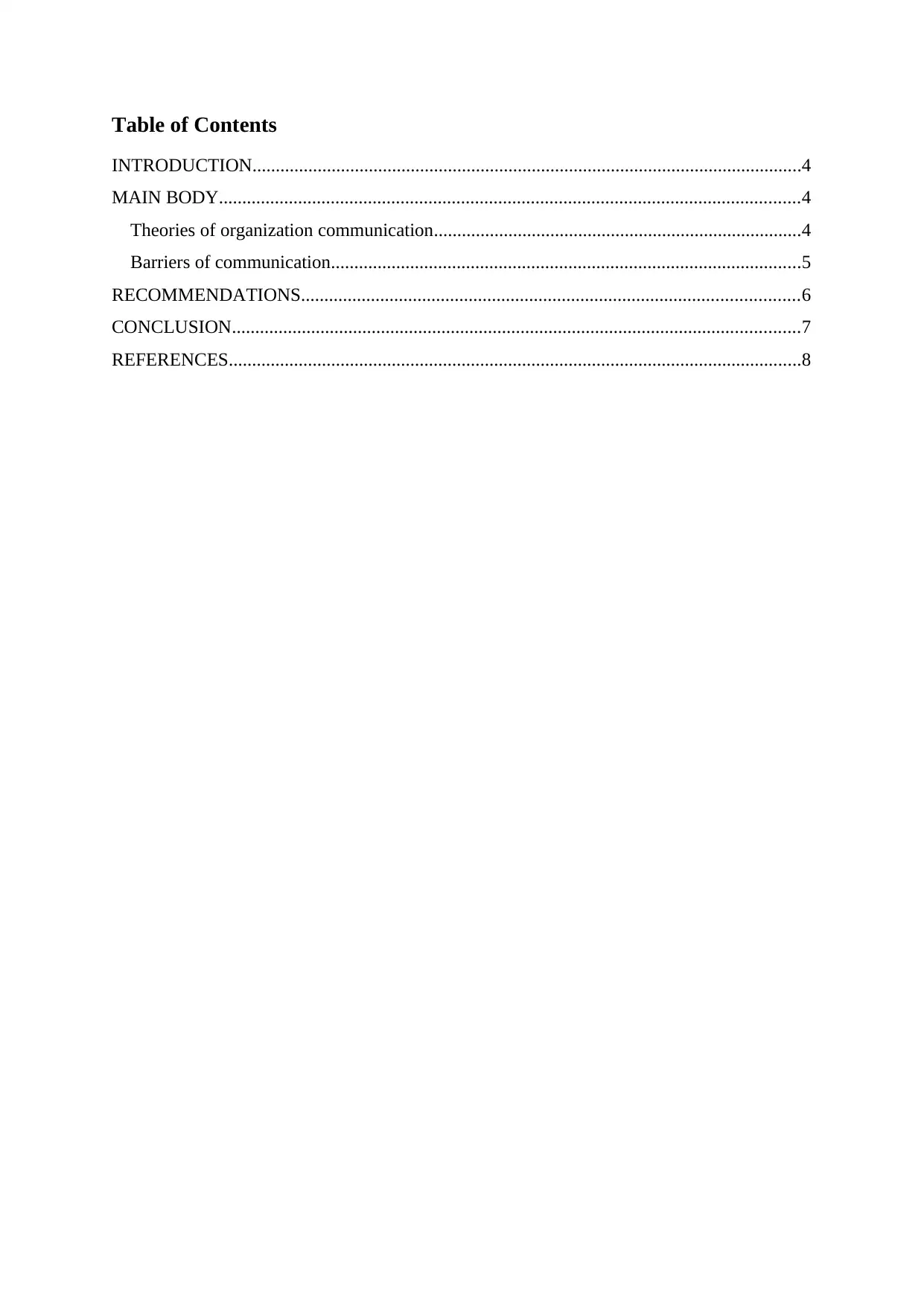
Table of Contents
INTRODUCTION......................................................................................................................4
MAIN BODY.............................................................................................................................4
Theories of organization communication...............................................................................4
Barriers of communication.....................................................................................................5
RECOMMENDATIONS...........................................................................................................6
CONCLUSION..........................................................................................................................7
REFERENCES...........................................................................................................................8
INTRODUCTION......................................................................................................................4
MAIN BODY.............................................................................................................................4
Theories of organization communication...............................................................................4
Barriers of communication.....................................................................................................5
RECOMMENDATIONS...........................................................................................................6
CONCLUSION..........................................................................................................................7
REFERENCES...........................................................................................................................8
⊘ This is a preview!⊘
Do you want full access?
Subscribe today to unlock all pages.

Trusted by 1+ million students worldwide
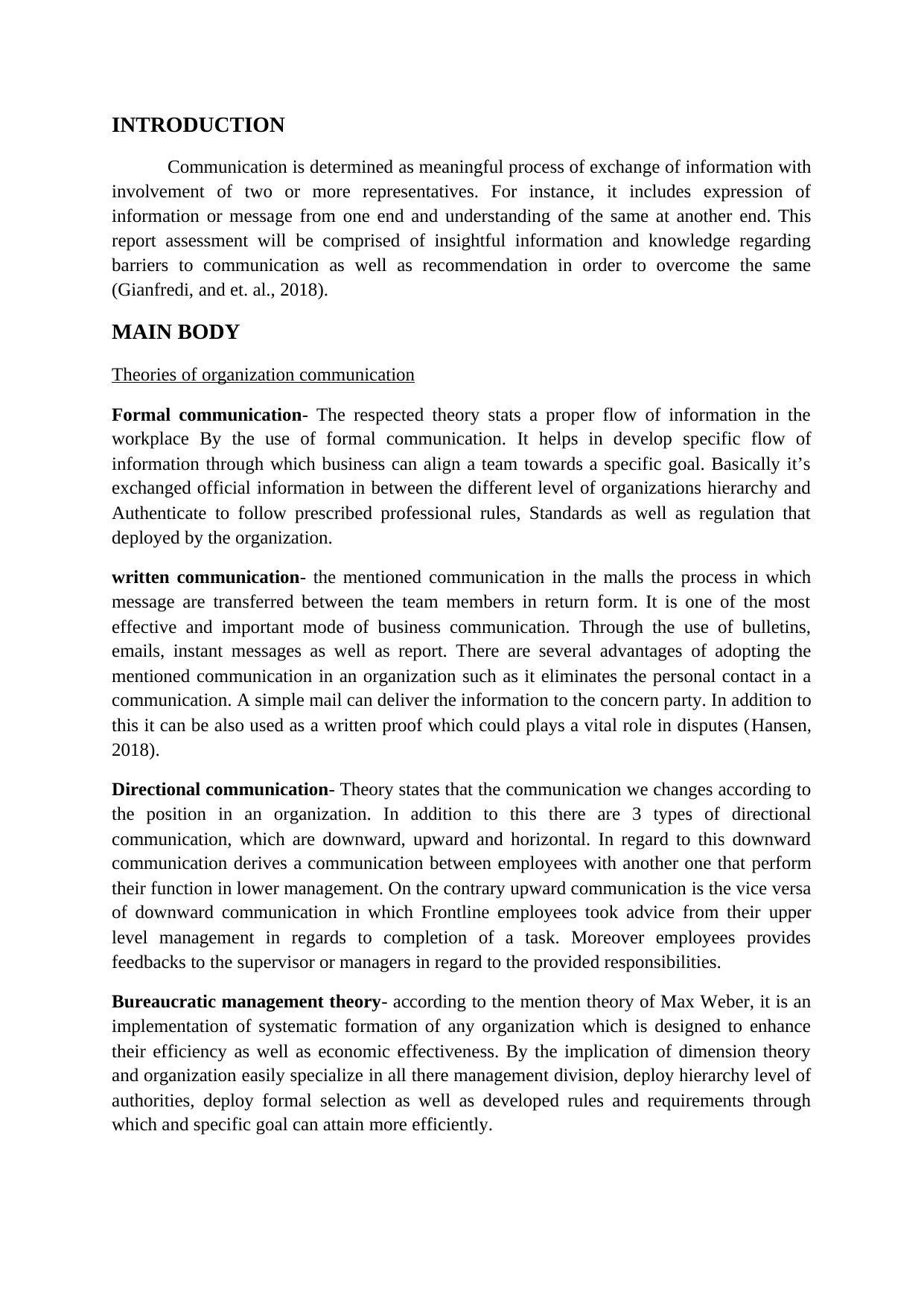
INTRODUCTION
Communication is determined as meaningful process of exchange of information with
involvement of two or more representatives. For instance, it includes expression of
information or message from one end and understanding of the same at another end. This
report assessment will be comprised of insightful information and knowledge regarding
barriers to communication as well as recommendation in order to overcome the same
(Gianfredi, and et. al., 2018).
MAIN BODY
Theories of organization communication
Formal communication- The respected theory stats a proper flow of information in the
workplace By the use of formal communication. It helps in develop specific flow of
information through which business can align a team towards a specific goal. Basically it’s
exchanged official information in between the different level of organizations hierarchy and
Authenticate to follow prescribed professional rules, Standards as well as regulation that
deployed by the organization.
written communication- the mentioned communication in the malls the process in which
message are transferred between the team members in return form. It is one of the most
effective and important mode of business communication. Through the use of bulletins,
emails, instant messages as well as report. There are several advantages of adopting the
mentioned communication in an organization such as it eliminates the personal contact in a
communication. A simple mail can deliver the information to the concern party. In addition to
this it can be also used as a written proof which could plays a vital role in disputes (Hansen,
2018).
Directional communication- Theory states that the communication we changes according to
the position in an organization. In addition to this there are 3 types of directional
communication, which are downward, upward and horizontal. In regard to this downward
communication derives a communication between employees with another one that perform
their function in lower management. On the contrary upward communication is the vice versa
of downward communication in which Frontline employees took advice from their upper
level management in regards to completion of a task. Moreover employees provides
feedbacks to the supervisor or managers in regard to the provided responsibilities.
Bureaucratic management theory- according to the mention theory of Max Weber, it is an
implementation of systematic formation of any organization which is designed to enhance
their efficiency as well as economic effectiveness. By the implication of dimension theory
and organization easily specialize in all there management division, deploy hierarchy level of
authorities, deploy formal selection as well as developed rules and requirements through
which and specific goal can attain more efficiently.
Communication is determined as meaningful process of exchange of information with
involvement of two or more representatives. For instance, it includes expression of
information or message from one end and understanding of the same at another end. This
report assessment will be comprised of insightful information and knowledge regarding
barriers to communication as well as recommendation in order to overcome the same
(Gianfredi, and et. al., 2018).
MAIN BODY
Theories of organization communication
Formal communication- The respected theory stats a proper flow of information in the
workplace By the use of formal communication. It helps in develop specific flow of
information through which business can align a team towards a specific goal. Basically it’s
exchanged official information in between the different level of organizations hierarchy and
Authenticate to follow prescribed professional rules, Standards as well as regulation that
deployed by the organization.
written communication- the mentioned communication in the malls the process in which
message are transferred between the team members in return form. It is one of the most
effective and important mode of business communication. Through the use of bulletins,
emails, instant messages as well as report. There are several advantages of adopting the
mentioned communication in an organization such as it eliminates the personal contact in a
communication. A simple mail can deliver the information to the concern party. In addition to
this it can be also used as a written proof which could plays a vital role in disputes (Hansen,
2018).
Directional communication- Theory states that the communication we changes according to
the position in an organization. In addition to this there are 3 types of directional
communication, which are downward, upward and horizontal. In regard to this downward
communication derives a communication between employees with another one that perform
their function in lower management. On the contrary upward communication is the vice versa
of downward communication in which Frontline employees took advice from their upper
level management in regards to completion of a task. Moreover employees provides
feedbacks to the supervisor or managers in regard to the provided responsibilities.
Bureaucratic management theory- according to the mention theory of Max Weber, it is an
implementation of systematic formation of any organization which is designed to enhance
their efficiency as well as economic effectiveness. By the implication of dimension theory
and organization easily specialize in all there management division, deploy hierarchy level of
authorities, deploy formal selection as well as developed rules and requirements through
which and specific goal can attain more efficiently.
Paraphrase This Document
Need a fresh take? Get an instant paraphrase of this document with our AI Paraphraser
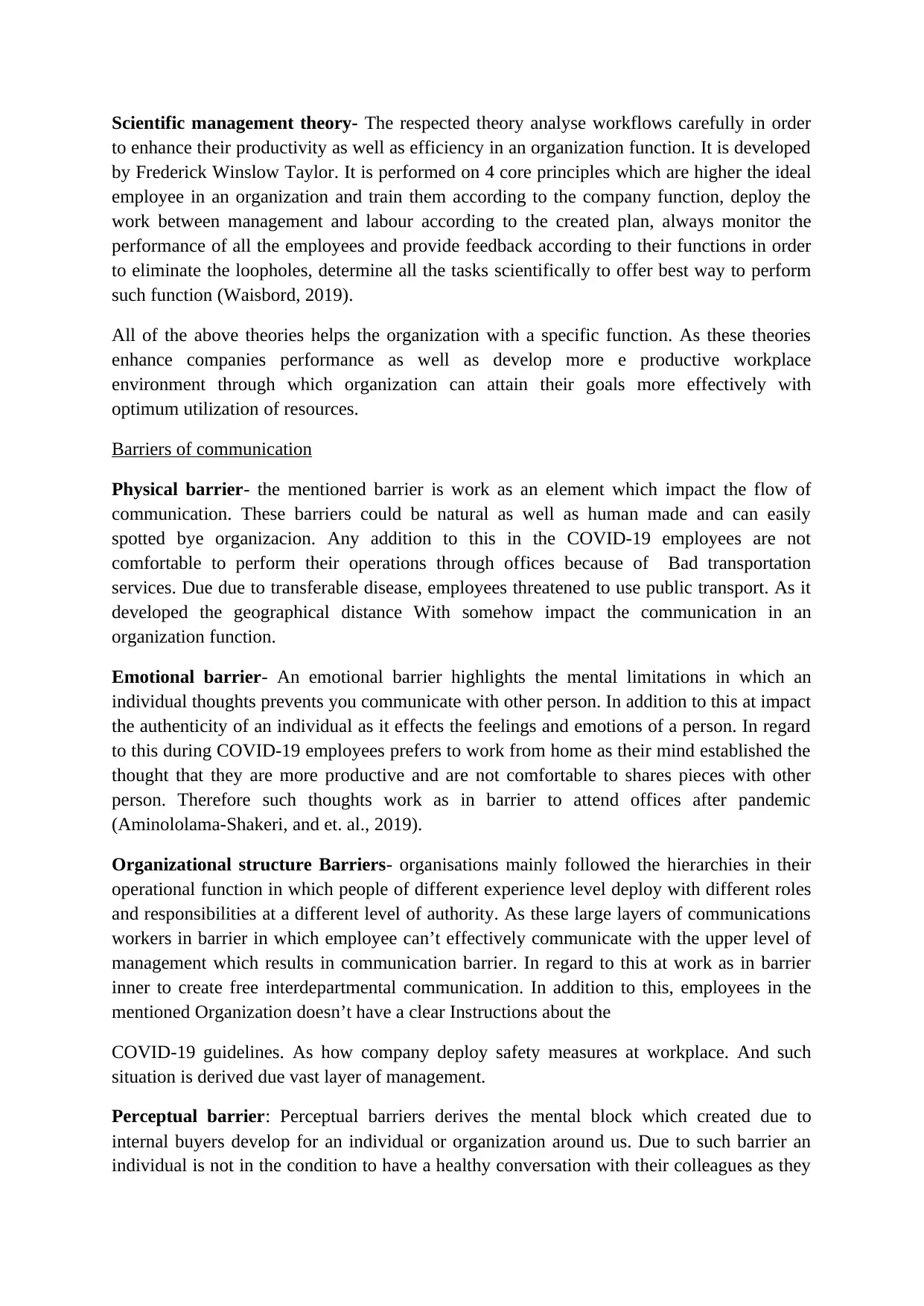
Scientific management theory- The respected theory analyse workflows carefully in order
to enhance their productivity as well as efficiency in an organization function. It is developed
by Frederick Winslow Taylor. It is performed on 4 core principles which are higher the ideal
employee in an organization and train them according to the company function, deploy the
work between management and labour according to the created plan, always monitor the
performance of all the employees and provide feedback according to their functions in order
to eliminate the loopholes, determine all the tasks scientifically to offer best way to perform
such function (Waisbord, 2019).
All of the above theories helps the organization with a specific function. As these theories
enhance companies performance as well as develop more e productive workplace
environment through which organization can attain their goals more effectively with
optimum utilization of resources.
Barriers of communication
Physical barrier- the mentioned barrier is work as an element which impact the flow of
communication. These barriers could be natural as well as human made and can easily
spotted bye organizacion. Any addition to this in the COVID-19 employees are not
comfortable to perform their operations through offices because of Bad transportation
services. Due due to transferable disease, employees threatened to use public transport. As it
developed the geographical distance With somehow impact the communication in an
organization function.
Emotional barrier- An emotional barrier highlights the mental limitations in which an
individual thoughts prevents you communicate with other person. In addition to this at impact
the authenticity of an individual as it effects the feelings and emotions of a person. In regard
to this during COVID-19 employees prefers to work from home as their mind established the
thought that they are more productive and are not comfortable to shares pieces with other
person. Therefore such thoughts work as in barrier to attend offices after pandemic
(Aminololama-Shakeri, and et. al., 2019).
Organizational structure Barriers- organisations mainly followed the hierarchies in their
operational function in which people of different experience level deploy with different roles
and responsibilities at a different level of authority. As these large layers of communications
workers in barrier in which employee can’t effectively communicate with the upper level of
management which results in communication barrier. In regard to this at work as in barrier
inner to create free interdepartmental communication. In addition to this, employees in the
mentioned Organization doesn’t have a clear Instructions about the
COVID-19 guidelines. As how company deploy safety measures at workplace. And such
situation is derived due vast layer of management.
Perceptual barrier: Perceptual barriers derives the mental block which created due to
internal buyers develop for an individual or organization around us. Due to such barrier an
individual is not in the condition to have a healthy conversation with their colleagues as they
to enhance their productivity as well as efficiency in an organization function. It is developed
by Frederick Winslow Taylor. It is performed on 4 core principles which are higher the ideal
employee in an organization and train them according to the company function, deploy the
work between management and labour according to the created plan, always monitor the
performance of all the employees and provide feedback according to their functions in order
to eliminate the loopholes, determine all the tasks scientifically to offer best way to perform
such function (Waisbord, 2019).
All of the above theories helps the organization with a specific function. As these theories
enhance companies performance as well as develop more e productive workplace
environment through which organization can attain their goals more effectively with
optimum utilization of resources.
Barriers of communication
Physical barrier- the mentioned barrier is work as an element which impact the flow of
communication. These barriers could be natural as well as human made and can easily
spotted bye organizacion. Any addition to this in the COVID-19 employees are not
comfortable to perform their operations through offices because of Bad transportation
services. Due due to transferable disease, employees threatened to use public transport. As it
developed the geographical distance With somehow impact the communication in an
organization function.
Emotional barrier- An emotional barrier highlights the mental limitations in which an
individual thoughts prevents you communicate with other person. In addition to this at impact
the authenticity of an individual as it effects the feelings and emotions of a person. In regard
to this during COVID-19 employees prefers to work from home as their mind established the
thought that they are more productive and are not comfortable to shares pieces with other
person. Therefore such thoughts work as in barrier to attend offices after pandemic
(Aminololama-Shakeri, and et. al., 2019).
Organizational structure Barriers- organisations mainly followed the hierarchies in their
operational function in which people of different experience level deploy with different roles
and responsibilities at a different level of authority. As these large layers of communications
workers in barrier in which employee can’t effectively communicate with the upper level of
management which results in communication barrier. In regard to this at work as in barrier
inner to create free interdepartmental communication. In addition to this, employees in the
mentioned Organization doesn’t have a clear Instructions about the
COVID-19 guidelines. As how company deploy safety measures at workplace. And such
situation is derived due vast layer of management.
Perceptual barrier: Perceptual barriers derives the mental block which created due to
internal buyers develop for an individual or organization around us. Due to such barrier an
individual is not in the condition to have a healthy conversation with their colleagues as they
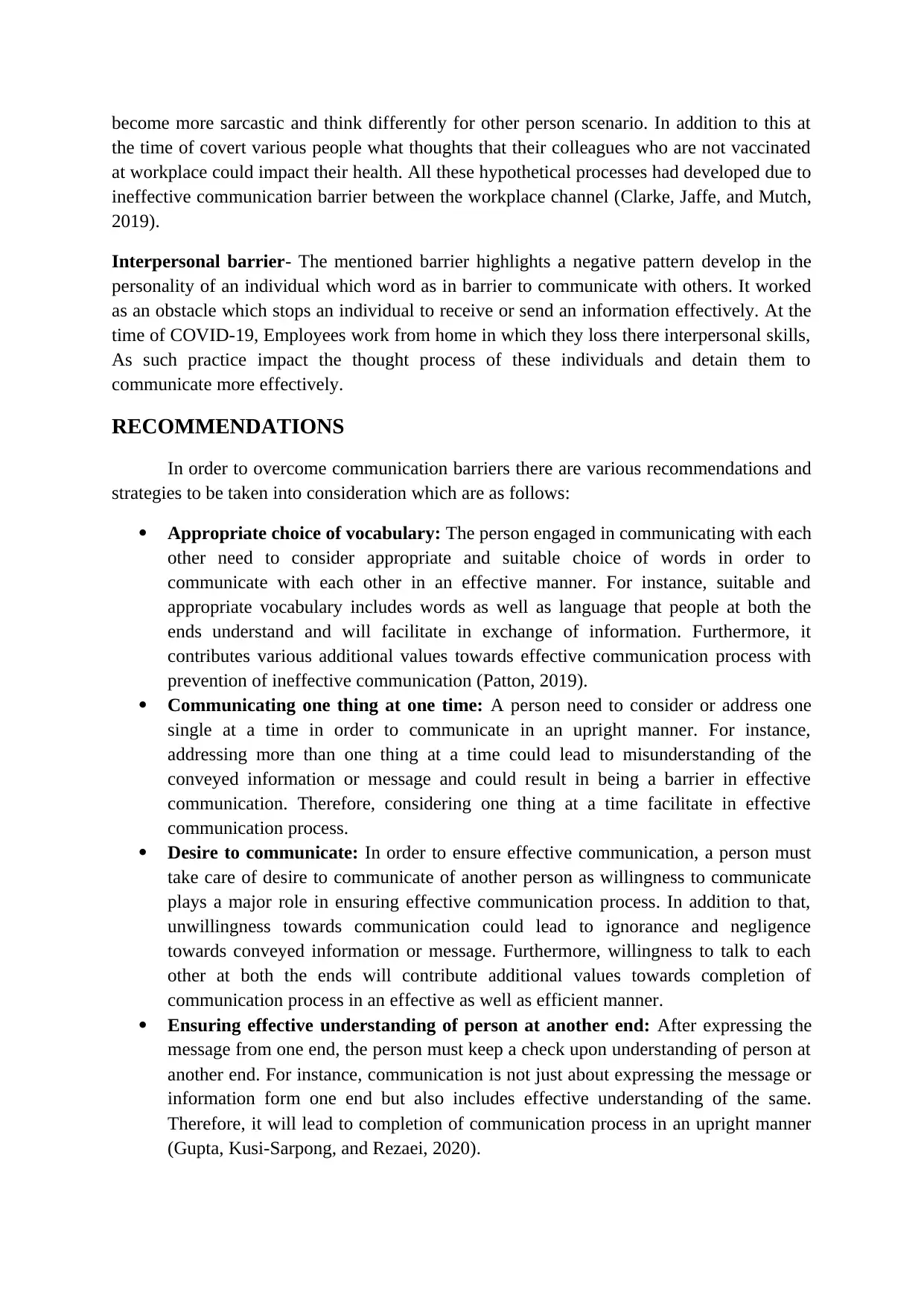
become more sarcastic and think differently for other person scenario. In addition to this at
the time of covert various people what thoughts that their colleagues who are not vaccinated
at workplace could impact their health. All these hypothetical processes had developed due to
ineffective communication barrier between the workplace channel (Clarke, Jaffe, and Mutch,
2019).
Interpersonal barrier- The mentioned barrier highlights a negative pattern develop in the
personality of an individual which word as in barrier to communicate with others. It worked
as an obstacle which stops an individual to receive or send an information effectively. At the
time of COVID-19, Employees work from home in which they loss there interpersonal skills,
As such practice impact the thought process of these individuals and detain them to
communicate more effectively.
RECOMMENDATIONS
In order to overcome communication barriers there are various recommendations and
strategies to be taken into consideration which are as follows:
Appropriate choice of vocabulary: The person engaged in communicating with each
other need to consider appropriate and suitable choice of words in order to
communicate with each other in an effective manner. For instance, suitable and
appropriate vocabulary includes words as well as language that people at both the
ends understand and will facilitate in exchange of information. Furthermore, it
contributes various additional values towards effective communication process with
prevention of ineffective communication (Patton, 2019).
Communicating one thing at one time: A person need to consider or address one
single at a time in order to communicate in an upright manner. For instance,
addressing more than one thing at a time could lead to misunderstanding of the
conveyed information or message and could result in being a barrier in effective
communication. Therefore, considering one thing at a time facilitate in effective
communication process.
Desire to communicate: In order to ensure effective communication, a person must
take care of desire to communicate of another person as willingness to communicate
plays a major role in ensuring effective communication process. In addition to that,
unwillingness towards communication could lead to ignorance and negligence
towards conveyed information or message. Furthermore, willingness to talk to each
other at both the ends will contribute additional values towards completion of
communication process in an effective as well as efficient manner.
Ensuring effective understanding of person at another end: After expressing the
message from one end, the person must keep a check upon understanding of person at
another end. For instance, communication is not just about expressing the message or
information form one end but also includes effective understanding of the same.
Therefore, it will lead to completion of communication process in an upright manner
(Gupta, Kusi-Sarpong, and Rezaei, 2020).
the time of covert various people what thoughts that their colleagues who are not vaccinated
at workplace could impact their health. All these hypothetical processes had developed due to
ineffective communication barrier between the workplace channel (Clarke, Jaffe, and Mutch,
2019).
Interpersonal barrier- The mentioned barrier highlights a negative pattern develop in the
personality of an individual which word as in barrier to communicate with others. It worked
as an obstacle which stops an individual to receive or send an information effectively. At the
time of COVID-19, Employees work from home in which they loss there interpersonal skills,
As such practice impact the thought process of these individuals and detain them to
communicate more effectively.
RECOMMENDATIONS
In order to overcome communication barriers there are various recommendations and
strategies to be taken into consideration which are as follows:
Appropriate choice of vocabulary: The person engaged in communicating with each
other need to consider appropriate and suitable choice of words in order to
communicate with each other in an effective manner. For instance, suitable and
appropriate vocabulary includes words as well as language that people at both the
ends understand and will facilitate in exchange of information. Furthermore, it
contributes various additional values towards effective communication process with
prevention of ineffective communication (Patton, 2019).
Communicating one thing at one time: A person need to consider or address one
single at a time in order to communicate in an upright manner. For instance,
addressing more than one thing at a time could lead to misunderstanding of the
conveyed information or message and could result in being a barrier in effective
communication. Therefore, considering one thing at a time facilitate in effective
communication process.
Desire to communicate: In order to ensure effective communication, a person must
take care of desire to communicate of another person as willingness to communicate
plays a major role in ensuring effective communication process. In addition to that,
unwillingness towards communication could lead to ignorance and negligence
towards conveyed information or message. Furthermore, willingness to talk to each
other at both the ends will contribute additional values towards completion of
communication process in an effective as well as efficient manner.
Ensuring effective understanding of person at another end: After expressing the
message from one end, the person must keep a check upon understanding of person at
another end. For instance, communication is not just about expressing the message or
information form one end but also includes effective understanding of the same.
Therefore, it will lead to completion of communication process in an upright manner
(Gupta, Kusi-Sarpong, and Rezaei, 2020).
⊘ This is a preview!⊘
Do you want full access?
Subscribe today to unlock all pages.

Trusted by 1+ million students worldwide
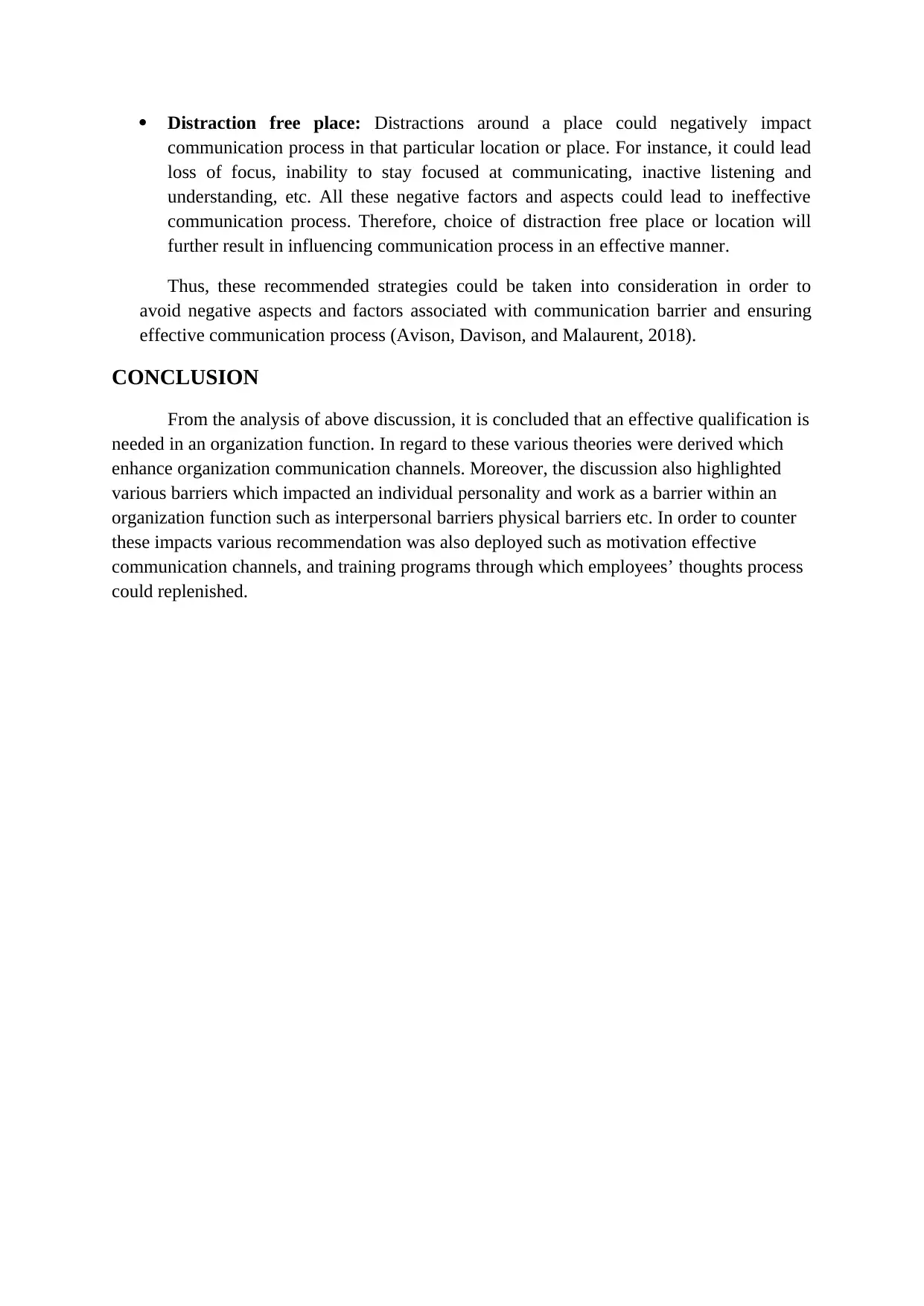
Distraction free place: Distractions around a place could negatively impact
communication process in that particular location or place. For instance, it could lead
loss of focus, inability to stay focused at communicating, inactive listening and
understanding, etc. All these negative factors and aspects could lead to ineffective
communication process. Therefore, choice of distraction free place or location will
further result in influencing communication process in an effective manner.
Thus, these recommended strategies could be taken into consideration in order to
avoid negative aspects and factors associated with communication barrier and ensuring
effective communication process (Avison, Davison, and Malaurent, 2018).
CONCLUSION
From the analysis of above discussion, it is concluded that an effective qualification is
needed in an organization function. In regard to these various theories were derived which
enhance organization communication channels. Moreover, the discussion also highlighted
various barriers which impacted an individual personality and work as a barrier within an
organization function such as interpersonal barriers physical barriers etc. In order to counter
these impacts various recommendation was also deployed such as motivation effective
communication channels, and training programs through which employees’ thoughts process
could replenished.
communication process in that particular location or place. For instance, it could lead
loss of focus, inability to stay focused at communicating, inactive listening and
understanding, etc. All these negative factors and aspects could lead to ineffective
communication process. Therefore, choice of distraction free place or location will
further result in influencing communication process in an effective manner.
Thus, these recommended strategies could be taken into consideration in order to
avoid negative aspects and factors associated with communication barrier and ensuring
effective communication process (Avison, Davison, and Malaurent, 2018).
CONCLUSION
From the analysis of above discussion, it is concluded that an effective qualification is
needed in an organization function. In regard to these various theories were derived which
enhance organization communication channels. Moreover, the discussion also highlighted
various barriers which impacted an individual personality and work as a barrier within an
organization function such as interpersonal barriers physical barriers etc. In order to counter
these impacts various recommendation was also deployed such as motivation effective
communication channels, and training programs through which employees’ thoughts process
could replenished.
Paraphrase This Document
Need a fresh take? Get an instant paraphrase of this document with our AI Paraphraser
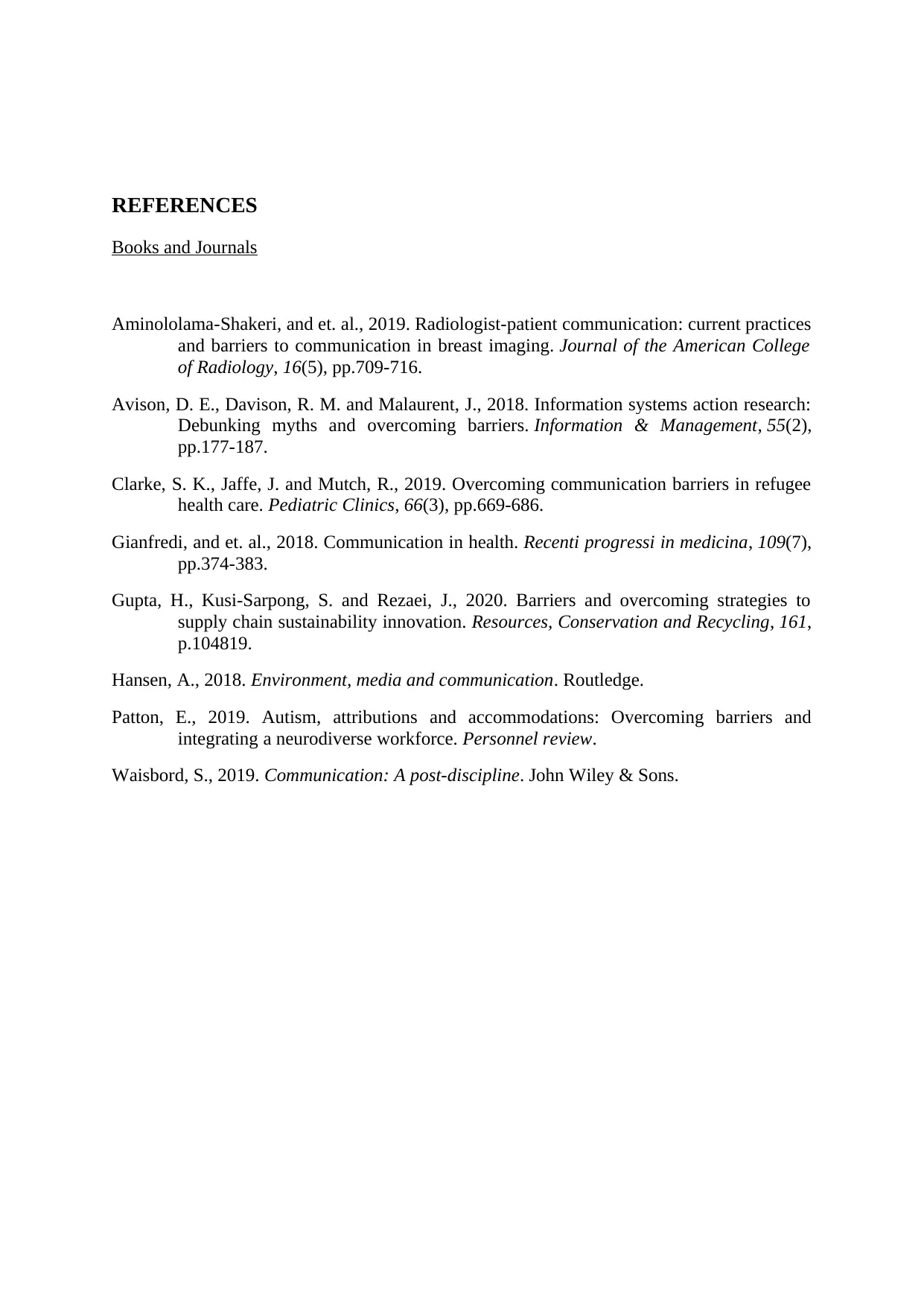
REFERENCES
Books and Journals
Aminololama-Shakeri, and et. al., 2019. Radiologist-patient communication: current practices
and barriers to communication in breast imaging. Journal of the American College
of Radiology, 16(5), pp.709-716.
Avison, D. E., Davison, R. M. and Malaurent, J., 2018. Information systems action research:
Debunking myths and overcoming barriers. Information & Management, 55(2),
pp.177-187.
Clarke, S. K., Jaffe, J. and Mutch, R., 2019. Overcoming communication barriers in refugee
health care. Pediatric Clinics, 66(3), pp.669-686.
Gianfredi, and et. al., 2018. Communication in health. Recenti progressi in medicina, 109(7),
pp.374-383.
Gupta, H., Kusi-Sarpong, S. and Rezaei, J., 2020. Barriers and overcoming strategies to
supply chain sustainability innovation. Resources, Conservation and Recycling, 161,
p.104819.
Hansen, A., 2018. Environment, media and communication. Routledge.
Patton, E., 2019. Autism, attributions and accommodations: Overcoming barriers and
integrating a neurodiverse workforce. Personnel review.
Waisbord, S., 2019. Communication: A post-discipline. John Wiley & Sons.
Books and Journals
Aminololama-Shakeri, and et. al., 2019. Radiologist-patient communication: current practices
and barriers to communication in breast imaging. Journal of the American College
of Radiology, 16(5), pp.709-716.
Avison, D. E., Davison, R. M. and Malaurent, J., 2018. Information systems action research:
Debunking myths and overcoming barriers. Information & Management, 55(2),
pp.177-187.
Clarke, S. K., Jaffe, J. and Mutch, R., 2019. Overcoming communication barriers in refugee
health care. Pediatric Clinics, 66(3), pp.669-686.
Gianfredi, and et. al., 2018. Communication in health. Recenti progressi in medicina, 109(7),
pp.374-383.
Gupta, H., Kusi-Sarpong, S. and Rezaei, J., 2020. Barriers and overcoming strategies to
supply chain sustainability innovation. Resources, Conservation and Recycling, 161,
p.104819.
Hansen, A., 2018. Environment, media and communication. Routledge.
Patton, E., 2019. Autism, attributions and accommodations: Overcoming barriers and
integrating a neurodiverse workforce. Personnel review.
Waisbord, S., 2019. Communication: A post-discipline. John Wiley & Sons.
1 out of 8
Related Documents
Your All-in-One AI-Powered Toolkit for Academic Success.
+13062052269
info@desklib.com
Available 24*7 on WhatsApp / Email
![[object Object]](/_next/static/media/star-bottom.7253800d.svg)
Unlock your academic potential
Copyright © 2020–2025 A2Z Services. All Rights Reserved. Developed and managed by ZUCOL.





